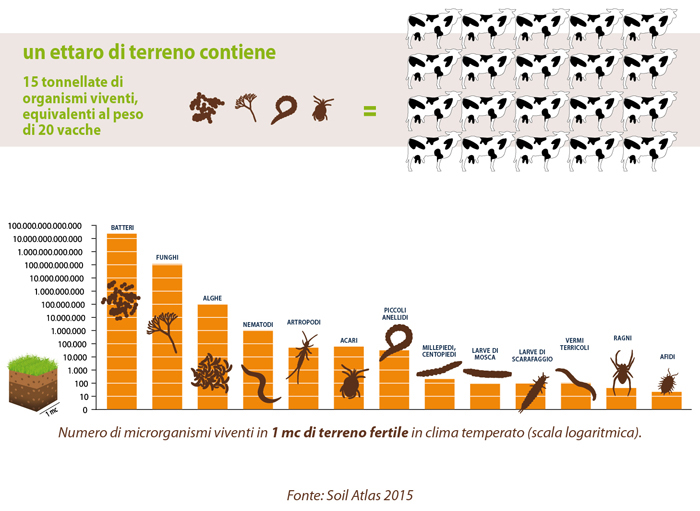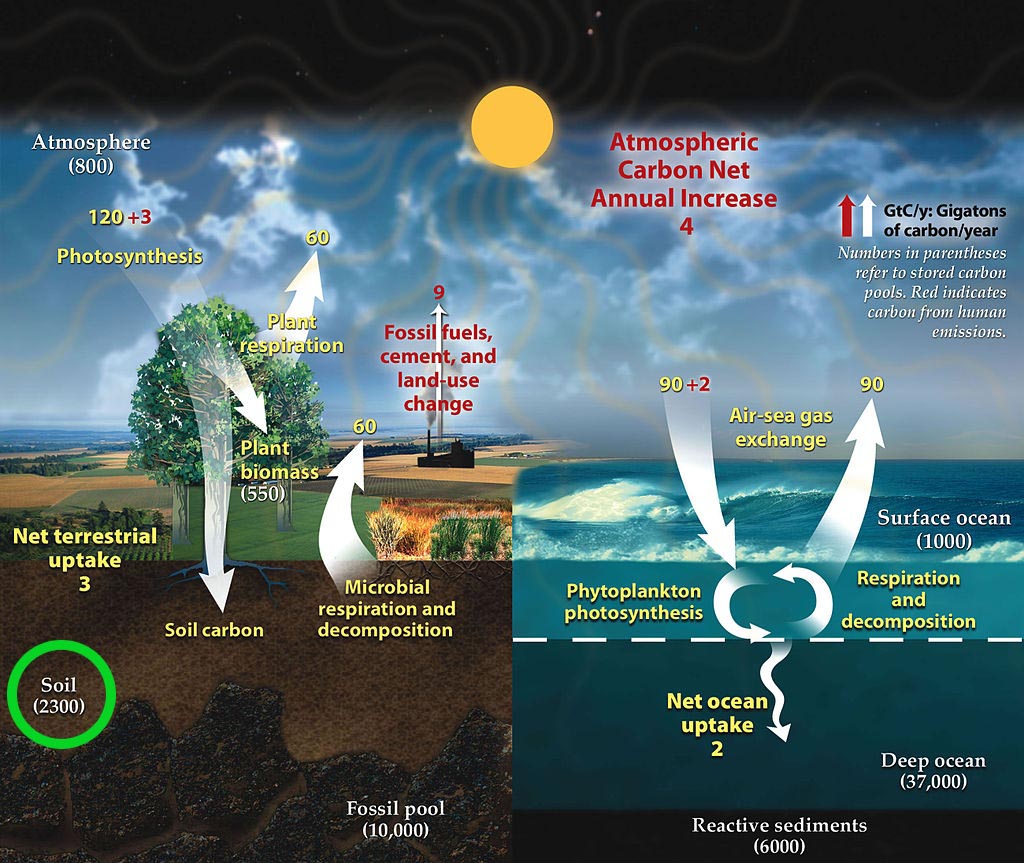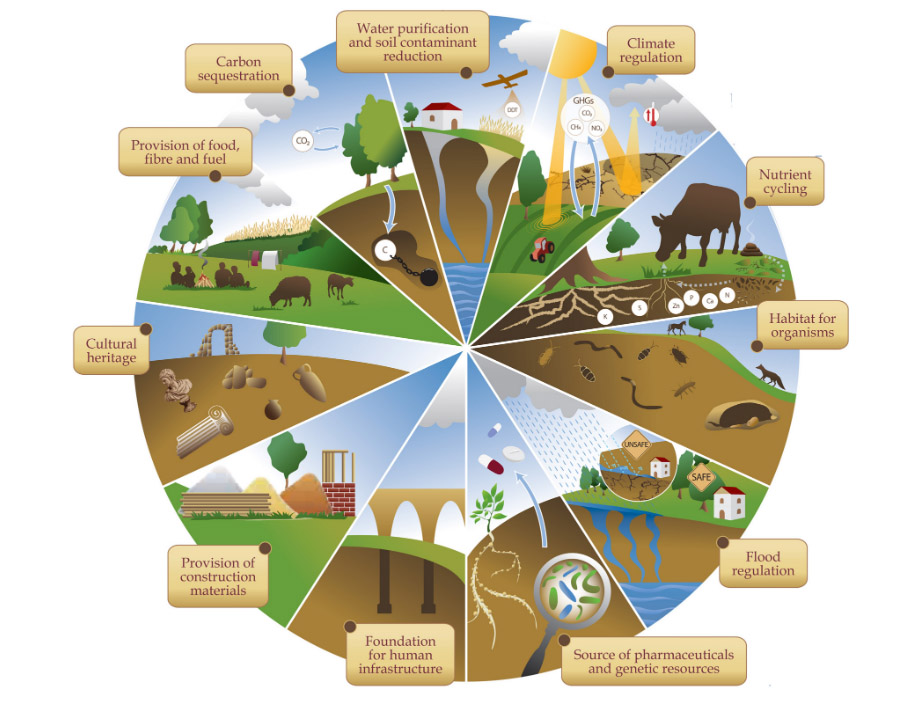The diversity and quantity of living forms in the soil. Source: Slow Food
Great workers live in the soil
Organisms living in the soil interact with each other, with plants and with small animals, forming a complex network of biological activity that contributes to all life on Earth through the major global cycles (of water, carbon and various elements essential to life). Soil provides us humans with a vast amount of ecosystem services such as food production, climate regulation and water purification, among others 6,7. Interestingly, due to the vastness and diversity of the soil, it has been estimated that, given the number of species of 100 million bacteria and 1.5 million fungi present in it, our understanding of the functions of its microbiota is limited to 0.02% for bacteria and 0.14% for fungi 8. Imagine, then, how many things soil organisms do for us without us even knowing it.
The carbon cycle. The soil is shown in the bottom left of the image, circled in green. Source Wikipedia.
What soil does for us
Although soil may appear to be a static entity, devoid of vitality and functionality, we have discovered that this is by no means the case.
The easiest way to understand how soil is a fundamental resource to human life is to discover the ecosystem services it provides us.
Ecosystem services are defined by the Millennium Ecosystem Assessment (2005)9 as the multiple benefits provided by ecosystems to humankind, i.e. all goods and services that directly or indirectly meet human needs 10.
-
Food and timber through fertility
For plants to grow and thrive, giving us food and timber, they need the soil to provide them with all the necessary nutrients such as nitrogen, phosphorous and potassium. These nutrients are present in the soil in a variable form because, as we have said before, the soil has a huge diversity of characteristics (if we think of a Siberian soil and an Amazonian one, we can imagine that the differences are many), and it is able to supply these fundamental elements thanks to the process of decomposition of organic matter (dead animals, plants and microbes), literally recycling matter 11! One of the fundamental processes for soil fertilization is humification, a process that is only activated under favorable conditions and generates a viscous substance that can influence soil water retention 12,13.
-
Carbon cycle and climate regulation
Soil is fundamental in the carbon cycle (a basic constituent of life on earth) and climate regulation. It represents the earth’s largest store of carbon, containing more than the atmosphere and vegetation combined 1,14. The role of the microbiota in determining the earth’s climate began millions of years ago, with the origin of life: the first oxygen molecules were produced by marine cyanobacteria 3.5 thousand million years ago, and archaea (bacteria living in the most extreme and inhospitable habitats on the planet) produced methane during the Carboniferous period 1. Thus, the soil being a vast resource of microbiota cannot but play a decisive role in regulating the earth’s climate.
-
Reserve and water filter
The water cycle is strongly influenced by the soil as it regulates the water cycle by storing it, but not only that: the soil filters the water and frees it from pollutants. In this way, the soil provides us with drinking water and regulates the flow of rivers, preventing flooding15. Crucial in this ecosystem service are the actions of ecosystem engineers (such as earthworms and ants) who create pores in the soil where water can penetrate, preventing it from quickly slipping away.
-
Filter for pollutants
As we have just said, soil purifies water of pollutants, thus it has the ability to be a filter and container for pollutants (such as heavy metals, organic pollutants and radionuclides 16), limiting their diffusion, thus mitigating their effects on the environment and human health 4.
-
Resource of active ingredients
Hosting a myriad of microbes and fungi, the soil is a veritable mine of medicines. How? Think of penicillin, an antibiotic developed from the fungus Penicillium chrysogenum and streptomycin, and also an antibiotic developed from the soil-dwelling bacterium Streptomyces griseus. It is clear that the biodiversity under our feet is a resource of chemical and genetic solutions for the development of new medicines 4 and for this reason, in addition to all other reasons, it must be protected and enhanced.
Schematic representation of soil ecosystem services. Source: Baveye et al. 2016 17
Let us remember the value of what we do not see
Soil is an example of how easy it is to take for granted or even ignore the value of what we do not see.
No matter how much human society is able to change the environment and no matter how capable it is of incredible inventions, it can never replace all the ecosystem services that nature provides completely free of charge and autonomously. The only thing that is strongly demanded and required is to respect this immeasurable value and do justice by not negatively impacting it, firstly because the most significant damage falls on us and secondly because a bit of gratitude never hurts!
For more information
Global Soil Biodiversity Atlas, available in pdf at this link https://esdac.jrc.ec.europa.eu/content/global-soil-biodiversity-atlas#tabs-0-description=0
Bibliography
- Orgiazzi, A., Bardgett, R. D. & Barrios, E. Global Soil Biodiversity Atlas. (European commission, 2016).
- European Commission & Directorate-General for Environment. COMMUNICATION FROM THE COMMISSION TO THE EUROPEAN PARLIAMENT, THE COUNCIL, THE EUROPEAN ECONOMIC AND SOCIAL COMMITTEE AND THE COMMITTEE OF THE REGIONS EU Soil Strategy for 2030 Reaping the benefits of healthy soils for people, food, nature and climate. (2021).
- FAO. Soils and biodiversity. (2015).
- Turbé, A., De Toni, A., Benito, P., Lavelle, P. & Ruia Camacho, N. Soil biodiversity: functions, threats and tools for policy makers. (2010).
- Voroney, R. P. & Heck, R. J. The soil habitat. in Soil Microbiology, Ecology, and Biogeochemistry 15–16 (Elsevier, 2015).
- Pulleman, M. et al. Soil biodiversity, biological indicators and soil ecosystem services—an overview of European approaches. Current Opinion in Environmental Sustainability 4, 529–538 (2012).
- Wall, D. H., Nielsen, U. N. & Six, J. Soil biodiversity and human health. Nature 528, 69–76 (2015).
- Starke, R., Capek, P., Morais, D., Callister, S. J. & Jehmlich, N. The total microbiome functions in bacteria and fungi. Journal of Proteomics 213, 103623 (2020).
- Ecosystems and Human Well-Being: Wetlands and Water Synthesis: A Report of the Millennium Ecosystem Assessment. (World Resources Institute, Washington, DC, 2005).
- Rodriguez-Eugenio, N., McLaughlin, M. & Pennock, D. Soil Pollution: A Hidden Reality. (FAO, Rome, 2018).
- Horwath, W. Carbon Cycling: The Dynamics and Formation of Organic Matter. in Soil microbiology, ecology and biochemistry. 339–377 (Elsevier, 2015).
- Guo, Y. et al. Organic amendments enhanced the humification degree in soil formation of bauxite residue. Plant Soil (2022) doi:10.1007/s11104-022-05773-y.
- Mycorrhizosphere and Pedogenesis. (Springer Singapore, Singapore, 2019). doi:10.1007/978-981-13-6480-8.
- Lal, R., Monger, C., Nave, L. & Smith, P. The role of soil in regulation of climate. Phil. Trans. R. Soc. B 376, 20210084 (2021).
- FAO & ITPS. The role of soils in ecosystem processes (chapter 2). in Status of the World’s Soil Resources (SWSR) – Main Report. (Rome, 2015).
- Chenu, C., Rumpel, C. & Lehmann, J. Methods for studying soil organic matter: nature, dynamics, spatial accessibility, and interactions with minerals. in Soil microbiology, ecology and biochemistry. 383–411 (Elsevier, 2015).
- Baveye, P. C., Baveye, J. & Gowdy, J. Soil “Ecosystem” Services and Natural Capital: Critical Appraisal of Research on Uncertain Ground. Frontiers in Environmental Science 4, (2016).

Graduated in Environmental Humanities (UniVe) with a three-year background in Political Science (UniPd). She has been passionate about the environment since she was a child. In her specialisation she approached soil and agriculture. She firmly believes that it is essential to make environmental issues accessible to everyone in order to make significant changes to our impact on planet Earth. She sees Atmosphera Lab as an ideal platform to pursue this goal.









